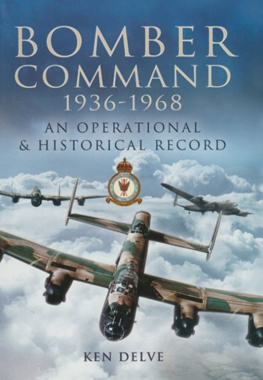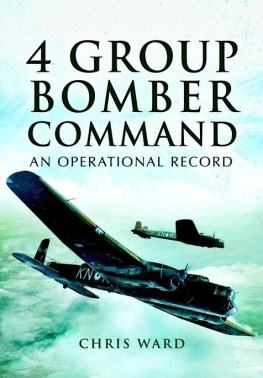
First published in Great Britain in 2008 by
Pen & Sword Aviation
an imprint of
Pen & Sword Books Ltd
47 Church Street
Barnsley
South Yorkshire
S70 2AS
Copyright Chris Ward and Steve Smith, 2008
ISBN 978-1-84415-796-9
eISBN 9781844687350
The right of Chris Wards and Steve Smith to be identified as Authors of this Work has been asserted by them in accordance with the Copyright, Designs and Patents Act 1988.
A CIP catalogue record for this book is available from the British Library
All rights reserved. No part of this book may be reproduced or transmitted in any form or by any means, electronic or mechanical including photocopying, recording or by any information storage and retrieval system, without permission from the Publisher in writing.
Typeset in 10/12 Times New Roman by
Concept, Huddersfield, West Yorkshire
Printed and bound in England by
CPI UK
Pen & Sword Books Ltd incorporates the Imprints of Pen & Sword Aviation,
Pen & Sword Maritime, Pen & Sword Military, Wharncliffe Local History,
Pen & Sword Select, Pen & Sword Military Classics, Leo Cooper,
Remember When, Seaforth Publishing and Frontline Publishing.
For a complete list of Pen & Sword titles please contact
PEN & SWORD BOOKS LIMITED
47 Church Street, Barnsley, South Yorkshire, S70 2AS, England
E-mail: enquiries@pen-and-sword.co.uk
Website: www.pen-and-sword.co.uk
Contents
Foreword
For some unfathomable reason hardly anything has been written about the exploits of Bomber Commands 3 Group during the Second World War. Numerous books have been written about the other Groups, recording their heroic involvement and sacrifices in Bomber Commands campaigns, but there is a conspicuous absence of a similar reference work on 3 Group. This sad omission is now rectified with this book. I have covered many 3 Group squadrons in my RAF Bomber Command Profile series, and have drawn heavily on those works.
I am fortunate to count Steve Smith as a good friend. He is the 218 Squadron archivist and a general authority on 3 Group as a whole. We often talked about a book, and now, at last, we have done something about it. Steve made available to me his massive store of Group, station and squadron records, and between us we decided what to include. When I write a book, I do so as if it were specifically for me. I like detail, facts and figures, dates, who did what and when. I like to bring everything about the subject under one cover, so that I dont have to delve and leaf through a library of books to find the snippet of information I want. I also like to think that I have included so much that there will be no point in another author covering the same subject. Of course, that is nonsense, as there is always something else to discover and to write. There is also not an infinite amount of space available, so much of what I would have put into a profile has had to be omitted. The narrative, therefore, reads very much like a diary of events, and is basically an account of Bomber Commands war, with the 3 Group involvement woven into it. Steve and I have tried to be even-handed with regard to the amount of information provided on each squadron, but obviously the longer serving units get the most mentions. One unique feature of 3 Group was its clandestine squadrons operating on behalf of SOE and SIS. They did not fit comfortably into wartime Bomber Command, but played a massively important role, and their story is a part of 3 Groups story. However, it is a story that requires a book in itself, and many fine works have been written on the subject providing a detailed operational history. We have recorded some events to give a flavour of the heroism of the crews of the moon squadrons and to acknowledge their part in the 3 Group story. Conversely, although the Pathfinder Force came nominally under the control of 3 Group until being granted its own Group status, we have chosen to treat it as being outside of 3 Group for the purpose of this book.
Finally, the story of Bomber Command is one principally of people, not aircraft, targets and bombs, and we have tried to reflect this in the personal information included. Much of the information in the narrative is backed up in the appendices, and readers will thereby be able to make a speedy reference to any point of interest. Steve and I fervently hope that we have done justice to those who served 3 Group in WWII as that magnificent and now aged generation fades into history.
General Notes
This is a reference work on the activities of 3 Group and the squadrons serving with it in an operational capacity at some time during the Second World War. Bomber Command operated exclusively from stations in the UK, and used overseas bases purely for shuttle operations, or as advanced staging posts for specific purposes. For this reason, periods spent on detachment, or permanent postings to overseas Commands do not fall within the scope of this work.
This work is not intended to serve as a comprehensive history of the Group or squadrons, but to provide as much information as possible about them in a non-anecdotal form. The brief history narrative is basically an account of Bomber Commands war, with the Groups involvement interwoven into it. The publications listed in the Bibliography are not only recommended reading, but represent the best available sources of information for serious students of the subject. The operational record is based almost entirely on the figures provided in The Bomber Command War Diaries by Martin Middlebrook and Chris Everitt, and I am indebted to Martin Middlebrook for allowing me to use them.
An aircraft is included in aircraft history section if:
(a) it spent time on squadron charge, no matter how briefly, and irrespectively of whether or not it operated, and;
(b) the type was used operationally by the squadron.
Information is restricted in most cases to where from and where to, unless it completed its service with the squadron, in which case, some detail of its demise appears. Aircraft which failed to return have the date and target recorded. Where no information follows the serial number of a type still in use when the squadron departed Bomber Command, or at wars end, it can be assumed that the aircraft was still on squadron strength. However, where there is a blank space following the serial number of a type which has been withdrawn from service with Bomber Command, it signifies that I dont know its ultimate fate. An absence of information does not imply that the aircraft flew no operations during its time with the squadron.
In the narrative we have selected 149 Squadron to be representative of a 3 Group Wellington unit, 218 Squadron for Stirlings and 115 Squadron for Lancasters. This enables us to be more detailed with regard to incidents and losses in the limited space available. It can be assumed that what happened to these units was typical across the Group.
Finally, information has been drawn from a variety of sources, ranging from Records Branch to individuals with squadron connections, and I am grateful for their contributions. There will, however, inevitably be errors and omissions when dealing with a subject as vast as Bomber Command.
A special mention is due to Chris Salter of Midland Counties Publications, without whose generous assistance and encouragement at the outset, I would not have been able to compile a complete list of all operational aircraft on charge with Bomber Command squadrons during the war period, a list, incidentally, which comprises some 28,000 entries.
C HAPTER O NE
Next page













